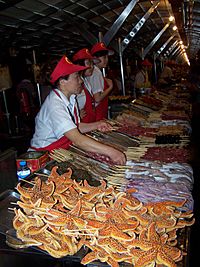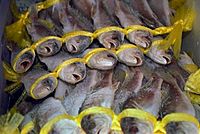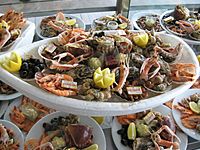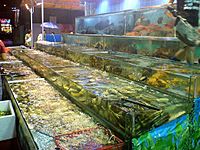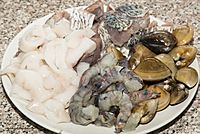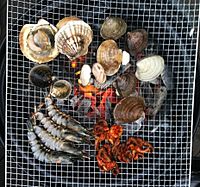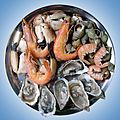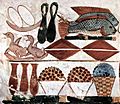Seafood facts for kids
Seafood is food that comes from fish or other animals that live in the sea, like shrimp and lobsters. Collecting seafood is known as fishing.
Seafood is full of protein and is generally considered a healthy food choice.
Contents
Different Kinds of Seafood
There are many types of seafood that people eat. Here's a look at some of the main groups:
| Group | Picture | Subgroup | What They Are Like |
|---|---|---|---|
| Fish | Fish are water animals with bones or cartilage instead of a backbone. They breathe using gills and don't have fingers or toes. | ||
 |
Ocean Fish (Pelagic) | Pelagic fish swim and eat near the surface or in the open water of the sea. They don't live on the bottom. Big pelagic fish include sharks, tuna, and salmon. Smaller ones are herring and sardines. | |
 |
Bottom Fish (Demersal) | Demersal fish live and eat on or near the bottom of the sea. Examples are cod and flatfish. These fish usually have white meat. | |
| Traveling Fish (Diadromous) | Diadromous fish travel between the sea and fresh water. Salmon and eels are examples. | ||
 |
Freshwater Fish | Freshwater fish live in rivers, lakes, and ponds. Common types are carp and tilapia. Many freshwater fish are raised on farms. | |
| molluscs | Molluscs are soft-bodied animals without backbones. Many have a hard shell that grows with them. | ||
 |
bivalves | Bivalves, like clams, have a shell made of two hinged parts. Important ones include oysters, scallops, and mussels. Most bivalves filter food from the water and live in the sand. | |
 |
Sea Snails (Gastropods) | Aquatic gastropods, also called sea snails, have a single shell. They seem to crawl on their stomachs. Examples are abalone and conch. | |
 |
cephalopods | Cephalopods do not have a shell. They have arms that seem to come from their head. They are very smart and have good eyesight. Octopus, squid, and cuttlefish are examples. | |
| Other Molluscs | This group includes other molluscs not listed above. | ||
| Crustaceans | Crustaceans are animals without backbones. Their bodies are covered by a hard outer shell, like a knight's armor. This shell does not grow, so they shed it regularly. Most have ten legs and eyes on stalks. Their shells often turn pink or red when cooked. | ||
 |
shrimps | Shrimp and prawns are small, thin crustaceans with long, spiny noses. They live in oceans, rivers, and lakes. They are a key part of the ocean's food chain. | |
 |
crabs | Crabs are ten-legged crustaceans that usually walk sideways. They have strong claws at the front. They have a wide, flat body. | |
 |
lobsters | Clawed lobsters and spiny lobsters are ten-legged crustaceans with long bodies. Clawed lobsters have one large crushing claw and one cutting claw. Spiny lobsters have long, spiny antennae. Lobsters are bigger than most shrimp or crabs. | |
 |
krill | Krill are tiny, shrimp-like animals with many legs. They live in huge groups in oceans worldwide. Krill are very important in the marine food chain, as many larger animals eat them. | |
| Other Crustaceans | This group includes other crustaceans not listed above. | ||
| Other Aquatic Animals | |||
 |
aquatic mammals | Marine mammals are animals like whales, dolphins, and seals that live in the ocean. Some cultures traditionally eat whale or dolphin meat. Seal meat is also an important food source for people in places like Nunavut and Alaska. | |
 |
Aquatic Reptiles | Sea turtles have been eaten as food for a long time in many parts of the world. However, hunting most species of sea turtles is now against the law because many are in danger of disappearing. | |
 |
echinoderms | Echinoderms are animals without heads that live on the seafloor in all oceans. They often have a five-pointed shape and spiky skin. Sea cucumbers and sea urchins are examples of echinoderms eaten as seafood. | |
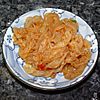 |
jellyfish | Jellyfish are soft, jelly-like animals that swim in the ocean. They have long tentacles that can sting. In some parts of Asia, like Japan, dried jellyfish is considered a special food. | |
 |
Other Aquatic Animals | This group includes other water animals not listed above, such as sea squirts. | |
| aquatic plants and microphytes | |||

|
seaweed | Seaweed is a general term for large algae that grow in the sea. Edible seaweeds have lots of fiber and protein. They have been eaten in places like China, Japan, and Korea for a very long time. | |
 |
microphytes | Microphytes are tiny living things, like very small algae or bacteria. Some, like spirulina, can be eaten by humans and animals. | |
How Seafood is Processed
Fish spoils very quickly. The "fishy" smell comes from chemicals released as the fish breaks down.
Some restaurants keep fish alive in tanks until they are ready to cook them. This is because many people prefer their seafood to be as fresh as possible.
Fresh fish needs to be eaten soon or kept very cold. In many places, fresh fish is cut into fillets and sold on crushed ice or in refrigerated displays. Thanks to refrigerated trains and trucks, fresh fish can now be found far from the coast.
For longer storage, fish can be preserved in different ways. The oldest methods are drying and salting. Fish like cod can be completely dried. Herring and mackerel are often partly dried and salted. Fish like salmon and tuna are often cooked and canned in sealed containers.
Eating Seafood Around the World
People all over the world eat seafood. It is a very important source of high-quality protein. More than a billion people rely on seafood as their main source of animal protein.
Iceland, Japan, and Portugal eat the most seafood per person.
In the UK, it is suggested that people eat at least two servings of seafood each week. One of these servings should be oily fish.
Taste and Texture of Seafood
There are over 33,000 different kinds of fish and many other sea animals. Chemicals from sea plants give marine animals a unique smell and taste that freshwater fish don't have.
Another chemical, called TMAO, is found in fish. It gives them a distinct smell. Fish from deeper parts of the ocean often have a stronger taste than those from shallow waters.
Even though there are many species, only a small number are commonly eaten by people.
| Common Seafood Types by Taste and Texture | |||
|---|---|---|---|
| Mild Flavor | Moderate Flavor | Full Flavor | |
| Soft Texture |
Basa, flounder, hake, smelt, rainbow trout, hardshell clam, blue crab, cuttlefish, oysters | anchovy, herring, orange roughy, Atlantic Ocean perch, sea urchin | Atlantic mackerel |
| Medium Texture |
black sea bass, European sea bass, cod, haddock, Alaska pollock, pink salmon, snapper, tilapia, turbot, walleye, cockle, crayfish, bay scallop, Chinese white shrimp | sablefish, Atlantic salmon, coho salmon, skate, dungeness crab, king crab, blue mussel, pink shrimp | escolar, chinook salmon, chum salmon, American shad |
| Firm Texture |
Arctic char, carp, catfish, grouper, halibut, monkfish, sturgeon, wahoo, yellowtail, Abalone, conch, stone crab, American lobster, spiny lobster, octopus, black tiger shrimp, squid | barramundi, mahimahi, swordfish, albacore tuna, yellowfin tuna, geoduck clam, sea scallop | barracuda, Chilean sea bass, cobia, eel, blue marlin, mullet, sockeye salmon, bluefin tuna |
Health Benefits of Seafood
Fish is a great part of a healthy diet. It provides important vitamins and minerals. Oily fish are rich in omega-3 fatty acids, which are good for your heart.
These omega-3 oils are found in every cell of the human body. They are needed for important body functions, like how your brain works.
Whitefish, like haddock and cod, are low in fat and calories. When eaten with oily fish, they can help protect against coronary heart disease and build strong bones and teeth.
Shellfish have a lot of zinc. Zinc is important for healthy skin, muscles, and for helping the body grow.
Images for kids
See also
 In Spanish: Producto del mar para niños
In Spanish: Producto del mar para niños




